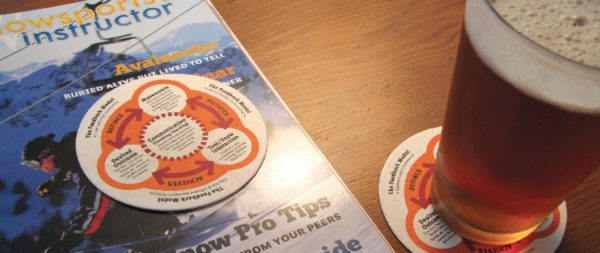 A Communication Framework
A Communication Framework
by Rick Lyons photos & illustration by Tyler Barnes
In 2007 the PSIA-NW Technical Team crafted the feedback model to help with the organization of information while assessing skiing/riding performance and to provide clearer, concise feedback. We introduced the model on a coaster, if you recall. That was a big hit, as people remember “the coaster” for some strange reason. Funny how that works. Maybe we should put my wedding anniversary or my wife’s birthday on a coaster, too!
What you may, or may not recall, is the article published in October 2007 in the Early Winter Issue of the NW Snowsports Instructor describing the feedback model and how you could use it.
We have now been working with and using the feedback model going into our 4th season. Let’s “reload” that article and update it with lessons learned and how the adoption of the model has progressed thus far.
Throughout the rest of the article I will add comments and notes to the originally published 2007 article. Here we go.
The model does not tell you how to conduct movement analysis in the sense of a method of observation (i.e. top down, bottom to top, whole to parts, or parts to whole, etc.). Its design is to help with what to do with the information after you have gathered it. Much of the information will sound familiar or something you already do; the goal of utilizing the model is consistency in your organization of information regarding and surrounding the areas of tool performance, movement patterns and desired outcomes and the delivery of that information.
At first glance the model (or feedback tool as many on the team also refer to it) may seem rather simple and you may ask yourself “How do I use it?” To answer this question let’s look at the components that make up the tool. Like the skills concept diagram, there is no prescribed way to start, no single concept is more important than another and you cannot rely solely on one concept to be successful in your analysis and subsequent teaching or coaching. The model is cyclical and you may begin the process at any of the bubbles. For this discussion let’s follow the order of Communication-> Desired Outcome –> Tool/Snow Interaction-> Movements. We’ve found this to be a nice introduction to the process and one you may be able to utilize more quickly.
Reloaded: I have found that sharing the concept of the model with my students, early in the lesson, can really help establish the lines of communication. I may not use the language described in the model directly but definitely the ideas. I find myself drawing the model in the snow on a regular basis with my students, this way we both know the areas the feedback will touch.
Communication
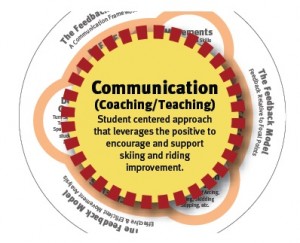 The center of the model – the “Communication” bull’s-eye, is likely the most important component of the model though it leverages the other pieces to be effective.
The center of the model – the “Communication” bull’s-eye, is likely the most important component of the model though it leverages the other pieces to be effective.
Without good communication the model breaks down. If we are not connecting, even the most accurate feedback will have little or no effect. The challenge with this bubble is “Leverage the Positive.” If you have been teaching for years you may be familiar with other language like, “error detection, fault correction or ineffective cues.” We have been trained for years to look for issues and give information like “stop that”, “don’t do this” or “you are still doing that thing.”
For some, pointing out what is wrong is the preferred feedback. For most of our clients this is likely not the case and if the feedback has a negative tone, especially at the beginning, we may be shutting down the lines of communication and in fact may cause them to stop doing what is working well. The concept of “leverage the positive” is to look for what is working well and enhancing it such that it helps reduce the issues. If you do in fact prefer to be told what you are doing wrong, communicating that to your coach would be considered leveraging a positive relationship.
Reloaded: Don’t forget communication is not just verbal. We receive information from Visual, Auditory and Kinesthetic means. I have found that touch can not only give my student feedback but I too get feedback that they understand. Ever ask you student to press their shins into the tongues of their boots? Ever stick your fingers in their boots to have them squish? You can even touch that muscle on the outside of the shin and ask them to “fire it” and “relax it” as the movement you are asking them to make facilitating the contact. Now you both know the muscle is firing. That’s communication!
Desired Outcome
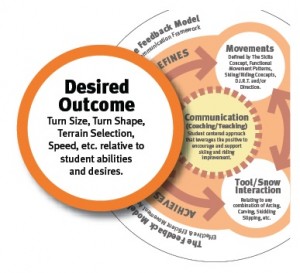 The next bubble to examine is “Desired Outcome.” This bubble is key to providing accurate feedback that connects with the receiver.
The next bubble to examine is “Desired Outcome.” This bubble is key to providing accurate feedback that connects with the receiver.
Have you ever been working on a specific movement and have someone give you feedback, out of the blue, about something completely different? If we don’t know the student’s intent, then giving feedback may have little or no meaning. If the student’s goal is to work on steering the feet and legs under the body and he receives feedback about hands, carving or edging, if that feedback is not tied back to the goal then it is ineffective. This falls right in line with good teaching; we always try to determine/establish goals with our students and often need to adjust those goals or create sub goals as a path to achieving the larger goal. Likewise, when providing feedback, if we tie it back to the desired outcome then the receiver will be more willing to accept and understand the feedback we provide.
Reloaded: If you are working to develop movements/skills, having clearly defined outcomes is paramount. As my use of the model has grown I have found myself getting more and more specific at defining the desired outcome. When presenting the drill or task, if I describe and show the outcome to the student, then have the student describe the desired outcome with me demonstrating it, this can really help anchor the concept. Then I help them with their demonstration of the desired outcome until they can perform it by themselves.
Tool/Snow Interaction
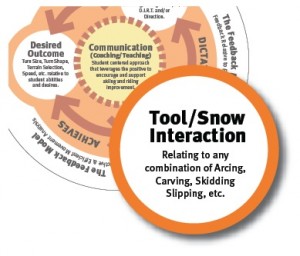 The next bubble “Tool/Snow Interaction” is often an overlooked or minimally discussed area.
The next bubble “Tool/Snow Interaction” is often an overlooked or minimally discussed area.
This could be termed the “Effect” bubble. What did the ski or board actually do in the snow? Was the turn round? What do the tracks look like? At what part of the turn do the edge(s) engage? Is the turn skidded, slipping or carved? Looking for the effects can lead us towards more accurately assessing achievement of the desired outcome. For example, if the desired outcome is a carved turn in which the edge(s) are engaged immediately, then we should be looking at the top of the turn as well as the fall-line and finish. Do the tips lead the tails? Is the turn “C” shaped where the top matches the bottom? Is the track generally the same width top to bottom? If so, great! If not, where was it good and when did the good begin and end? Armed with this information we can now move into determining the cause.
Reloaded: Overlooked? For sure! Ask yourself – “Did I relate that to tool/snow interaction?” After integrating the model into my feedback process I have an increased awareness of tool/snow interaction feedback usage. I have observed it being used less in intermediate and advanced zone lessons, whereas the beginner zone tends to discuss this interaction much more frequently. “Tip your ski to step sideways up the hill.” “Step you skis across the hill.” “Can you make your skis into the shape of a slice of pizza?”
Movements
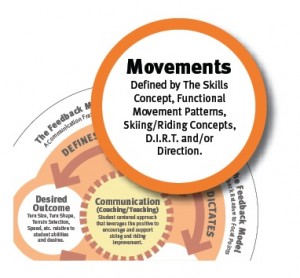 The last bubble “Movements” is the bubble where many of us tend to dwell, perhaps even too much. This could also be called the “Cause” bubble.
The last bubble “Movements” is the bubble where many of us tend to dwell, perhaps even too much. This could also be called the “Cause” bubble.
This bubble is where a large number of tools exist we are familiar with: The Skills Concept, Functional Movement Patterns, Skiing/Riding Concepts, Fundamental Movements and more. In our previous example, the carved turn, we can start looking for movements associated with the effects we noted. Let’s say the track was not quite “C” shaped and the top width was wider than the bottom. This would indicate the top part of the turn was being twisted of steered off. Knowing this we could start looking for movements that would cause the twisting/steered top. Or to “leverage the positive” look for the movements when the track is achieving the goal, then keying on those “good” movements change the Duration, Rate, Timing or Intensity to help achieve the goal throughout the turn.
Reloaded: Most instructors and students want feedback in the “Movements” bubble, this is the how part of the puzzle, so spending time in this area is required. Don’t forget the other “bubbles,” in fact leveraging them will strengthen your feedback.
It is important to understand the model is a balance and blend of the three concepts: Desired Outcome, Tool/Snow Interaction and Movements and that they are always changing depending on the student and the situation presented to you as an instructor. It is your understanding of that information which makes this model work. From the new instructor to the seasoned pro, the Feedback Model allows each to apply the information received and use it successfully. As your knowledge base and experience grows so too will the level you are able to use and apply the model.
We’re not trying to recreate the wheel, in fact these concepts have been around for many years and have been brought together and organized in such a way so they can be used effectively while consistently giving well rounded feedback to those you are working with.
Reloaded: The Feedback Model has helped me grow into a much more effective instructor and coach. It may be more appropriately named “The Feedback Tool” because it is something in my toolkit that I utilize on a daily basis.
[connections_list id=11 template_name=”div_staff_bio”]
One thought on “Feedback Model Reloaded”
Good article Rick! Way to go.